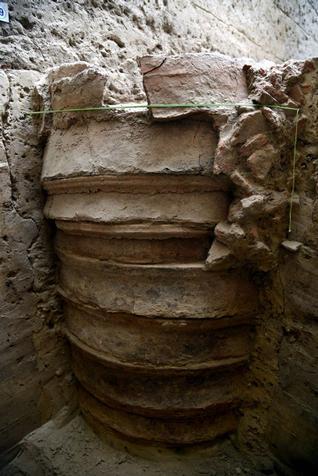Pheroze L. Vincent
Source - http://www.thehindu.com/news/cities/Delhi/ring-well-discovered-in-purana-qils-excavation/article6062618.ece

A ring well found during excavation at Purana Qila in New Delhi on Thursday. Photo: Sandeep Saxena – The Hindu
Towards the end of the latest excavation at Purana Qila, which began in January this year, the Archaeological Survey of India (ASI) has discovered a ring well 4.4 metres below the earth.
The well, 70 centimetres in diameter, lined with earthen rings is characteristic of the Maurya period. “This along with fragments of northern black earthenware and grey ware unearthed are proof that the excavation has reached up to the Mauryan period which was from 322 to 185 BC”, said Assistant Superintending Archaeologist Vishnu Kant to The Hindu.
The well is in a vertical excavation shaft approachable by a ladder. Beside it is a drain, probably of a kitchen in the Maurya period.
The excavation on a slope behind the Sher Mandal is akin to a time portal. At the very top, remnants of the post partition camps are found. As the slope progresses, excavations at various level reveal different ages of history. First are the ruins of the Mughals (1526 to 1857) followed by the Sultanate (1206 to 1526). Then the Rajput period (600 to 1200 AD) appears in excavations where fine disposable earthenware and an entombed skeleton of a small goat have been discovered.
As we go lower, excavations shafts reveal remains of the Gupta and post Gupta period (300 to 600 AD), the Kushan period (0 to 200 AD), the Sungas (200BC to 1BC) and finally the Mauryas in continuous sequence.
Mr. Kant added: "We have not been able to find a link to the Mahabharata period. It is said that the five villages demanded by the Pandavas included Indraprastha which falls within the present day Delhi. Evidence of that period is usually painted grey ware. We have not been able to find these at the level of that period.”
Grey pottery with black patterns have been found at later levels or from eras after the Mahabharata period. These, Mr. Kant explained, are smaller fragments which may have resurfaced in rain flow and were then used by children as play objects.
This is the third and the largest excavation here since the first one in 1955 by pioneering archaeologist Braj Basi Lal. Several labourers and 18 students of the Institute of Archaeology, Red Fort along with ASI staff led by Vasant Swarnkar, Superintending Archaeologist of the Delhi Circle.
So far, the excavations have revealed an 18 centimetre tall Vishnu idol, believed to be from the Rajput era although alternately it is also claimed to be from Akbar’s reign. In addition to this, a Gupta terracotta seal and stamped pottery, Mughal beads and gems and Sultanate glazed ware have also been found. An exhibition of the recovered artefacts in April saw a massive turnout and Purana Qila in public imagination is now more than just a haunt for lovers.